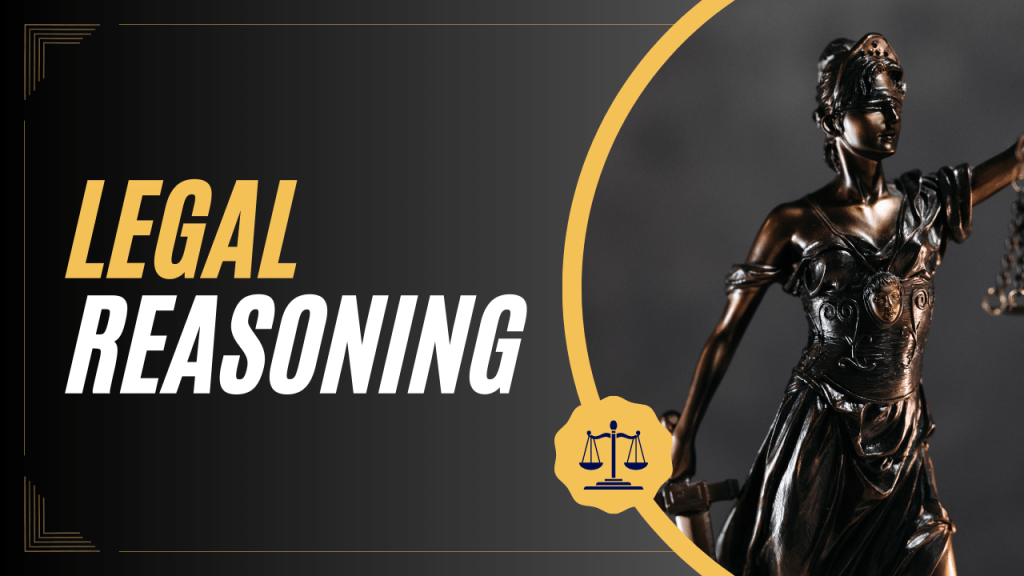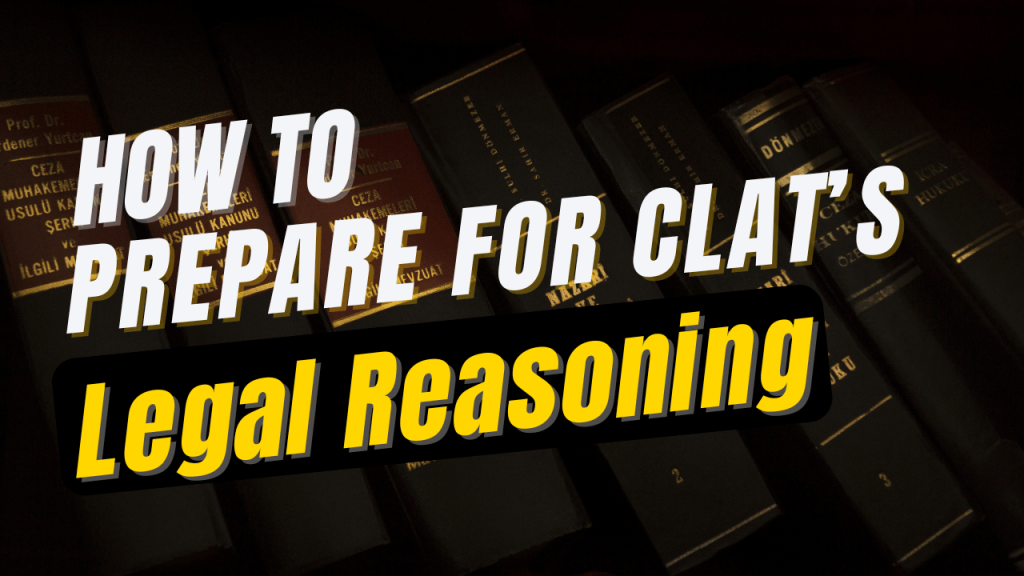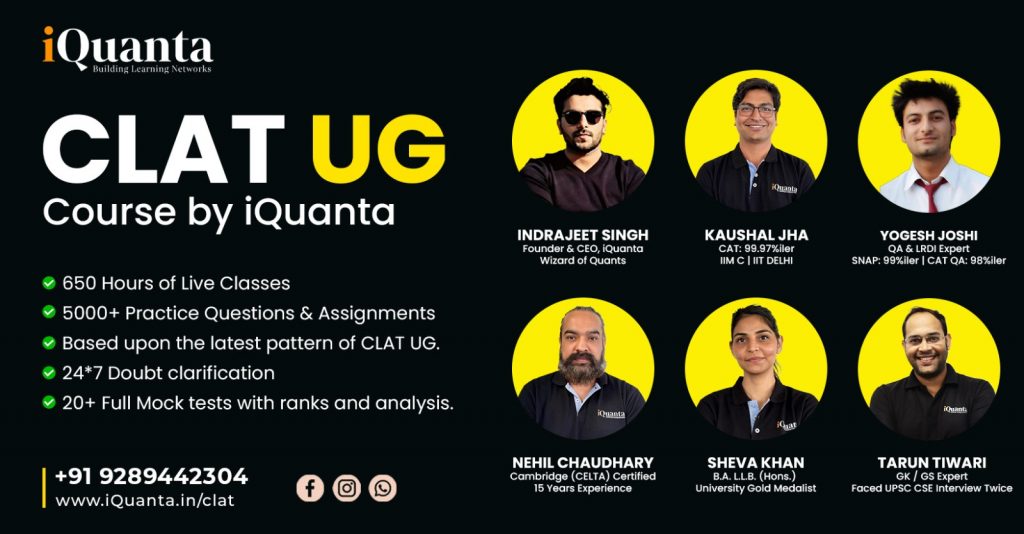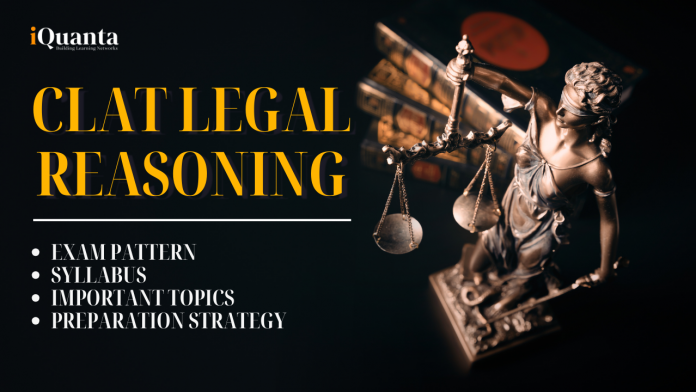This article will discuss the CLAT Legal Reasoning section of the CLAT UG exam. We have mentioned the syllabus, strategy, books, and preparation tips.
The CLAT exam consists of 5 sections, English Language, Legal Reasoning, General Knowledge, Logical Reasoning, and Quantitative Aptitude. Legal Aptitude holds one of the highest weightage of 25%, same as the current affairs and GK section, making it one of the most important sections in the CLAT exam. Let’s discuss this section in detail:-

Also Read: CLAT Eligibility Criteria
CLAT Legal Reasoning: An Overview
| Heads | Particulars |
|---|---|
| No. of Questions | 28-32 |
| Marks for every correct answer | 1 mark |
| Marks for every incorrect answer | -0.25 mark |
Among the five sections in the CLAT exam, the Legal Reasoning section holds a vital role in the CLAT exam. In this section, there are passages of about 450 words which you have to read, comprehend, and draw logical conclusions. The passages are related to Legal situations and scenarios. This section does not require any prior knowledge of the Law but your knowledge of contemporary legal and moral issues will complement you in your CLAT exam. This section has around 28-32 questions in the exam, accounting for 25% of the CLAT exam. The Consortium of NLUs says the candidates in the Legal Reasoning section will be required to:-
- Identify and draw conclusions about the rules and principles presented in the passage.
- Apply such rules and principles to various fact situations; and
- Understand how changes to the rules or principles may alter their application to various fact situations.
Get first CLAT Online Coaching by iQuanta!
CLAT Legal Reasoning Important Topics

The Legal Reasoning section of CLAT accounts for 25% of the whole exam. The following are the important topics and the most commonly asked questions in this section:-
- Law of contracts
- Personal Laws
- Constitution
- Law of Torts
- Criminal Laws
- Important Supreme Court Judgements
Also Read: Top 10 NLUs in India
Best Books for Legal Reasoning
You may have heard of the proverb that “Books are a person’s best friend”. Similarly, these books are your best friend for the CLAT’s Legal Reasoning section which will fuel your CLAT Preparation.
- Legal Awareness and Legal Reasoning by A P Bhardwaj
- Universal’s CLAT Guide
Also read: Best CLAT Books for the CLAT exam
Types of Questions Asked in the CLAT Legal Reasoning Section
The types of Legal Reasoning questions in the CLAT exam fall under two categories:
- Principle-Fact Questions: In this type, you are given a factual situation and a legal principle, you must apply the given principle to the facts and determine the most appropriate conclusion.
- Legal Knowledge Questions: You may be asked to identify the legal provision related to a given situation or recognize the legal implications of certain actions. These questions are framed to assess the candidates’ understanding of legal concepts, maxims, and landmark judgments.
Also Read: NLU Fees Structure
Example-
To better understand this section we have mentioned below the types of questions asked in the Legal Reasoning section of the CLAT exam.
Harm suffered voluntarily does not constitute a legal injury and is not actionable. This principle
is embodied in the maxim volenti non fit injuria. A person cannot complain of harm to the
chances of which he has exposed himself with his free consent and free will. The maxim volenti
non fit injuria is founded on good sense and justice. A person who has invited or assented to
an act being done towards him cannot, when he suffers from it, complain of it as a wrong. The
maxim presupposes a tortious act by the defendant. The maxim applies, in the first place, to
intentional acts which would otherwise be tortious. There are certain limitations to the
application of this maxim:
(i) It is no answer to a claim made by a workman against his employer for injury caused through
a breach by the employer of a duty imposed upon him by a statute. But where the negligence
or breach of statutory duty is on the part of an employee of the plaintiff who knowingly accepts
the risk flowing from such breach and the employer-defendant is not guilty of negligence or
breach of statutory duty, the defence of volenti non fit injuria is available to the defendant.
(ii) Under an exigency caused by the defendant’s wrongful misconduct, consciously and
deliberately faced a risk, even of death, whether the person endangered is one to whom he owes
a duty of protection, as a member of his family, or is a mere stranger to whom he owes no such
special duty. The rescuer will not be deprived of his remedy merely because the risk which he runs is not the same as that run by the person whom he rescues. But where there is no need to
take any risk, the person suffering harm in doing so cannot recover.
(iii) To cover a case of negligence the defence on the basis of the maxim must be based on
implied agreement whether amounting to contract or not. The defence is available only when
the plaintiff freely and voluntarily, with full knowledge of the nature and extent of the risk
impliedly agreed to incur it and to waive any claim for injury. But when the plaintiff has no
choice or when the notice is given at a stage when it is beyond the ability of the plaintiff to
make a choice there can be no implied agreement and the defence on the basis of the maxim
must fail.
(iv) The maxim will also not apply when the act relied upon is done because of the
psychological condition which the defendant’s breach of duty had induced.
Get Free CLAT Study Material by iQuanta
[CLAT 2021 Legal Reasoning)
Q1. Mr. A was the owner of a car and he had a driver- Mr. D. On January 19, 2021, Mr. A and
Mr. D were travelling in their car wherein Mr. A got down at a restaurant and told Mr. D
to take the car back to Mr. A’s bungalow. Mr. D was filling the petrol tank of the car, and
two strangers- Mr. B and Mr. C took a lift from Mr. D in his car. The car went ahead and
the right-side front wheel of the car flew away, the car toppled and Mr. D and Mr. C were
thrown out. Mr. C sustained severe injuries and ultimately died due to those injuries on
January 20, 2021. Mr. B and legal representatives of Mr. C claimed compensation from
Mr. A and Mr. D.
(A) Mr. D will be liable to pay the compensation.
(B) Volenti non fit injuria will be applicable and no compensation can be claimed.
(C) Volenti non fit injuria will not be applicable and compensation can be claimed.
(D) Mr. A and Mr. D both will be liable to pay the compensation.
[Correct Option: B]
Q2. Rama was a spectator at a motor car race being held on a track owned by the defendant
company. During the race, there was a collision between two cars, one of the cars was
thrown among the spectators, thereby injuring Rama severely. Which of the following
statements is correct?
(A) Rama impliedly took the risk of such injury, the danger being inherent in the sport
which any spectator could foresee, the defendant was not liable.
(B) It was a negligence on the part of defendant and volenti non fit injuria will be
applicable.
(C) Rama did not take the risk of such injury, and she only consented to watching the
race and hence the defendant was liable.
(D) Rama was negligent and hence she suffered injuries.
[Correct Option: A]
Q3. Which of the following is correct about consent in volenti non fit injuria?
(A) Knowledge of the risk does not always amount to consent.
(B) Knowledge of a risk does not precede consent.
(C) Knowledge of the risk always amounts to consent.
(D) Mere perception of the existence of danger amounts to consent.
[Correct Option: A]
Q4. Lily had placed spring guns in a wood on her ground for the protection of the garden.
Karan, with full knowledge that there were spring guns somewhere in the wood, trespassed
on the land of Lily and was injured. Which of the following statements is correct?
(A) Lily will be liable to pay compensation to Karan.
(B) Lily has not committed a tort against Karan by exceeding her right of private
defence.
(C) Karan’s case does not fall within volenti non fit injuria.
(D) Karan had knowledge of the spring guns and wilfully courted the danger himself.
[Correct Option: D]
Q5. Which of the following is not an element to claim the defence of volenti non fit Injuria?
(A) Prior knowledge of the plaintiff about the risk involved.
(B) Free consent.
(C) Plaintiff is compelled to agree to a risk by the defendant.
(D) Voluntary acceptance of the risk by the plaintiff.
[Correct Option: C]
The Question given above was asked in the Legal Reasoning section of CLAT 2021.
How to prepare for CLAT’s Legal Reasoning Section?

The following set of skills will help you to master the legal reasoning section of the CLAT exam:-
- Understanding Legal Principles: Aspirants must be well-versed in fundamental legal principles and rules. Regular reading of legal materials, including statutes and landmark cases, is crucial.
- Critical Analysis: Legal reasoning demands the ability to critically analyze situations. Candidates should practice dissecting scenarios, identifying relevant facts, and applying legal principles logically.
- Legal Vocabulary: Building a strong legal vocabulary is essential for interpreting complex legal texts in the CLAT Legal Reasoning. Aspirants should familiarize themselves with legal terms and phrases commonly used in judgments and statutes.
- Precedent Awareness: CLAT often tests candidates’ knowledge of precedent cases. Understanding how past judgments influence current legal interpretations is crucial.
- Scenario-based Reasoning: Given the principle-fact nature of questions, candidates must develop a knack for scenario-based reasoning. Regular practice with mock tests and previous years’ question papers can enhance this skill.
- Time Management: CLAT is known for its time constraints, and legal reasoning is no exception. Candidates should practice answering questions within the stipulated time to ensure efficiency during the actual exam.
Also read: CLAT 2024 Exam Analysis
Conclusion
The CLAT legal reasoning section is more than just rote memory. To succeed in this section, you must have a thorough comprehension of legal principles, critical thinking skills, and the ability to apply legal knowledge in real-world scenarios.
Aspirants should use legal reasoning as an opportunity to demonstrate their analytical prowess and problem-solving abilities, establishing the groundwork for a prosperous legal career. With thorough preparation and strategic study approaches, passing the CLAT legal reasoning part is not just a challenge, but also a stepping stone to a fulfilling career in Law.
If you are looking for structured CLAT preparation along with 24*7 doubt-solving facility, you can rely on iQuanta’s CLAT 2025 course.


